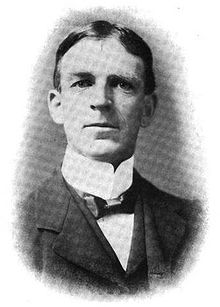William Wallace Campbell
William Wallace Campbell (born April 11, 1862 in Hancock County (Ohio) , † June 14, 1938 in San Francisco ) was an American astronomer.
He worked at the Lick Observatory from 1891 and from 1901 to 1923 he was director of the Lick Observatory and professor. He was then President of the University of California from 1923 to 1930 .
He dealt with star spectroscopy, e.g. B. Radial velocity of stars and discovery of binary stars with spectroscopic methods. He also led several eclipse expeditions.
In 1906 he was honored with the gold medal of the Royal Astronomical Society , in 1902 in the National Academy of Sciences , in 1903 in the American Philosophical Society , in 1911 in the American Academy of Arts and Sciences and in 1918 in the Royal Society and in the Académie des Sciences . In 1915 he was awarded the Bruce Medal . In 1920 he was elected an Honorary Fellow of the Royal Society of Edinburgh . Since 1924 he was a corresponding member of the Russian Academy of Sciences . From 1931 to 1935 he was President of the National Academy of Sciences.
In 1970 a lunar crater, in 1973 a Martian crater and in 1987 the asteroid (2751) Campbell was named after him.
Web links
- Publications by WW Campbell in the Astrophysics Data System
- Obituaries for WW Campbell in the Astrophysics Data System
- Entry on Campbell, William Wallace (1862–1938) in the Archives of the Royal Society , London
Individual evidence
- ^ Entry in Walter Greulich (Ed.), Lexikon der Physik, Spektrum Akademische Verlag 1998, Volume 1
- ^ Fellows Directory. Biographical Index: Former RSE Fellows 1783–2002. Royal Society of Edinburgh, accessed October 15, 2019 .
- ^ Foreign members of the Russian Academy of Sciences since 1724. William Wallace Campbell. Russian Academy of Sciences, accessed September 26, 2015 .
- ↑ William Wallace Campbell in the Gazetteer of Planetary Nomenclature of the IAU (WGPSN) / USGS
- ↑ William Wallace Campbell in the Gazetteer of Planetary Nomenclature of the IAU (WGPSN) / USGS
- ↑ Minor Planet Circ. 12457
| personal data | |
|---|---|
| SURNAME | Campbell, William Wallace |
| BRIEF DESCRIPTION | American astronomer |
| DATE OF BIRTH | April 11, 1862 |
| PLACE OF BIRTH | Hancock County (Ohio) |
| DATE OF DEATH | June 14, 1938 |
| Place of death | San Francisco |
